What Are phlebotomists? A Complete Guide to This Essential Medical Profession
In the world of healthcare, manny vital roles work behind the scenes to ensure patients receive accurate diagnoses and effective treatments. One such profession is **phlebotomy**, which involves drawing blood samples essential for tests, transfusions, donations, and medical research. But **what exactly are phlebotomists**, and what does this role entail? In this complete guide, we’ll explore the responsibilities, skills, training requirements, benefits, and practical tips for aspiring and current phlebotomists. Whether you’re considering a career in healthcare or seeking to understand this crucial role, this article provides all the information you need.
What Are Phlebotomists?
Phlebotomists are trained healthcare professionals specialized in the collection of blood samples from patients for diagnostic testing, blood donations, or research.They are sometimes also known as venipuncture technicians or clinical phlebotomists. Their primary task is to perform blood draws safely, efficiently, and with minimal discomfort for patients.
Key Responsibilities of a Phlebotomist
- Collect blood samples using various techniques such as venipuncture or capillary puncture.
- Label and prepare blood specimens for laboratory testing.
- maintain proper records of sample collection.
- Explain procedures to patients and provide reassurance.
- Ensure compliance with safety standards and infection control protocols.
- Transport specimens to laboratories accurately and promptly.
- Assist with other blood-related procedures, such as blood donations.
Essential Skills and Qualities of a Phlebotomist
- Attention to detail: Accurate labeling and handling of samples.
- Steady hand and manual dexterity: Precise needle placement.
- Excellent communication skills: Comforting patients and explaining procedures.
- patience and compassion: handling anxious or arduous patients.
- Knowledge of safety protocols: Infection control and proper disposal methods.
- Physical stamina: Standing for long periods and handling equipment.
How to Become a Phlebotomist
Educational Requirements
Most employers require at least a high school diploma or GED. subsequently, prospective phlebotomists can pursue specialized training programs that are often offered by community colleges, technical schools, or hospitals.
Phlebotomy certification
while certification isn’t always mandatory, obtaining it can enhance employability and demonstrate professional competence. Certified phlebotomists tend to have better job prospects and higher earning potential.
Popular Certification agencies
- American Society for Clinical Pathology (ASCP)
- National Phlebotomy Association (NPA)
- American Medical Technologists (AMT)
- National Healthcareer Association (NHA)
training Content Overview
| Module | Focus |
|---|---|
| Blood collection techniques | Venipuncture, capillary puncture |
| Safety and infection control | Proper handling, PPE, disposal |
| Patient communication | Explaining procedures, calming techniques |
| Laboratory procedures | Specimen labeling, handling, transport |
Benefits of a Career as a Phlebotomist
- Entry-level chance: Short training duration allows swift entry into healthcare.
- Job stability: High demand due to ongoing need for blood testing.
- Versatility: Opportunities for part-time or full-time work, and shifts in hospitals, clinics, or blood banks.
- Rewarding work: Playing a vital role in patient diagnosis and care.
- Potential for advancement: Moving into supervisory roles or specialized fields like immunohematology.
Practical Tips for Success
- Get proper training and certification to ensure competence and credibility.
- Practice patience and empathy, especially with anxious or difficult patients.
- Stay updated with safety standards and laboratory procedures.
- Develop good communication skills to explain procedures clearly.
- Maintain physical health and stamina to perform tasks efficiently.
- Build a professional network and consider joining associations for ongoing education.
Case Study: A Day in the Life of a Phlebotomist
Meet Sarah: A certified phlebotomist working at a busy hospital. Her day involves drawing blood from diverse patients,including children,elderly,and those anxious about needles.She emphasizes gentle technique, clear communication, and infection control. Her attention to detail ensures that all samples are properly labeled and delivered promptly, contributing directly to accurate diagnoses and patient outcomes.
Conclusion
Phlebotomists are an indispensable part of the healthcare system, bridging the gap between patients and diagnostic laboratories. Their expertise in blood collection, dedication to safety, and compassionate care make them vital to accurate medical testing and treatment. If you’re interested in a healthcare career that combines technical skills with patient interaction, becoming a phlebotomist could be an excellent choice.With proper training,certification,and a commitment to excellence,you can enjoy a rewarding and stable profession in this essential medical field.
Remember, successful phlebotomy depends on skill, patience, and a caring attitude. Whether you’re just starting or looking to advance your career, continuous learning and professional development will ensure you stay current in this dynamic healthcare role.
